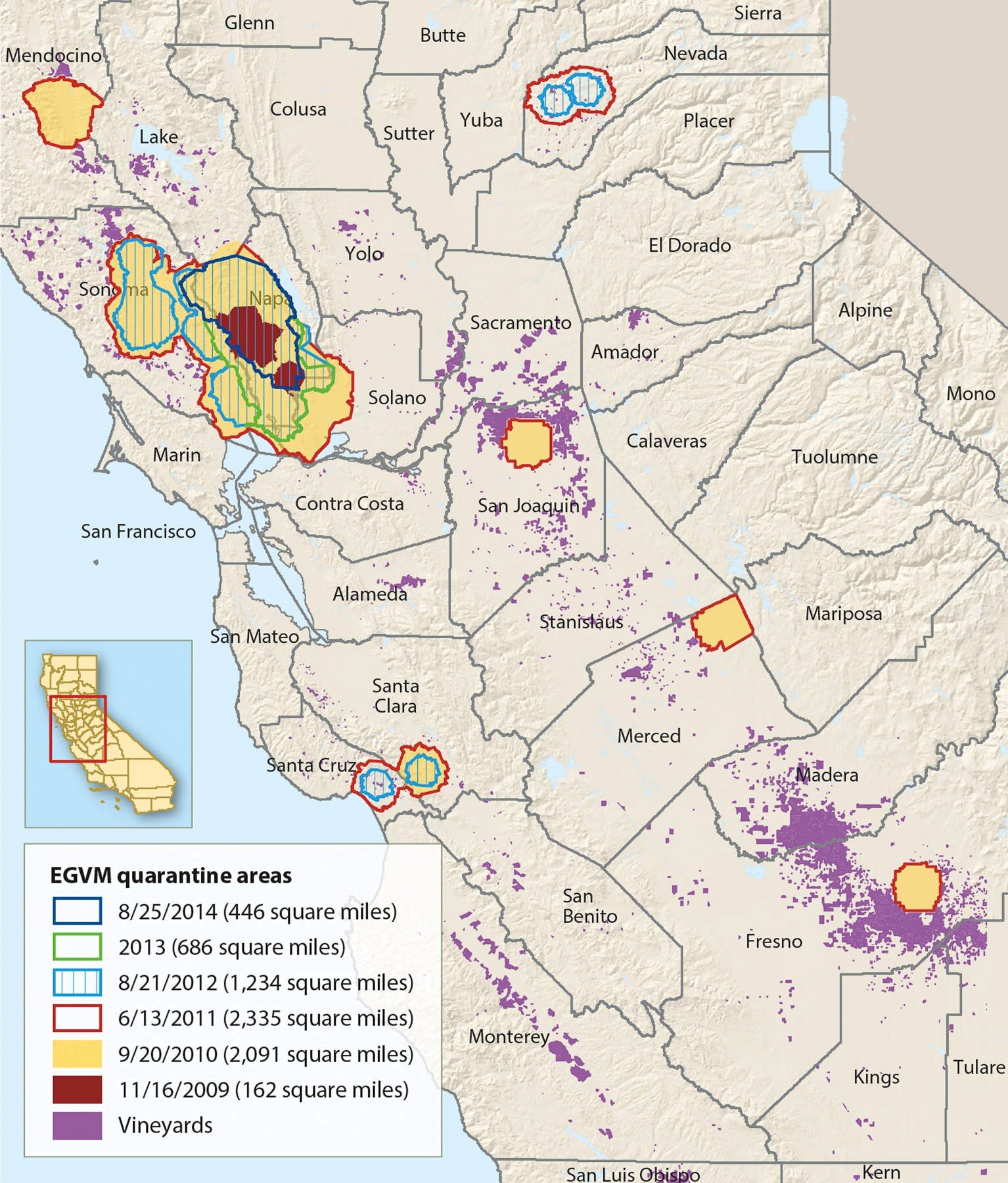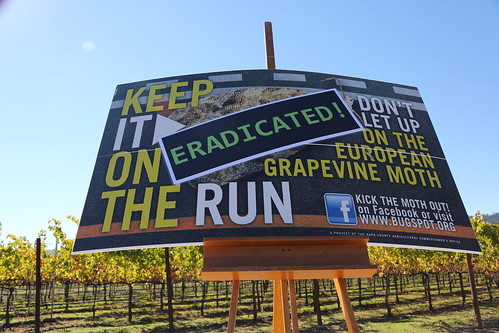For some reason, our culture seems to be fascinated by a good murder mystery. I think we all believe that murder is a horrible thing, but we love a story about “good guys” solving a murder case using smarts, careful observation and maybe a little luck. Then we can celebrate when they finally crack the case. “In Cold Blood”, Truman Capote’s book on the 1959 murder of a family in Kansas, played a large role in the growth of the true crime genre. The podcast, Serial, kicked off the most recent true crime renaissance, paving the way for many other true crime podcasts as well as series and documentaries like Netflix’s “Making a Murderer” and HBO’s “The Jinx.” And, who can discount the influence the show “Law & Order” has had, fueling our appetite for stories “ripped from the headlines”? But what about plants? Can they be murdered? Well there certainly are cases where people “murder” plants in a way that is bad, like deforestation.
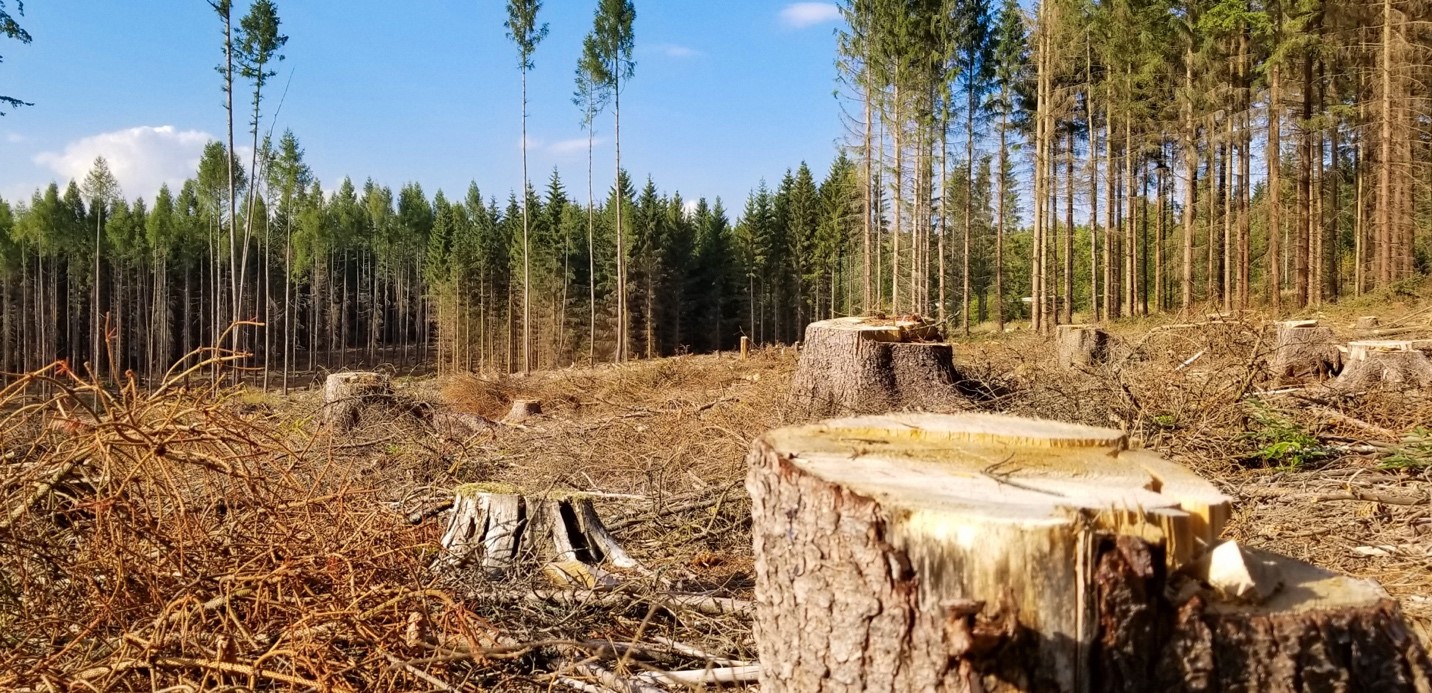
Image of deforestation
by Vera Kratochvil. Actually this was originally a
pest-based mass murder – bark beetle infestation
(purchased image)
But plants are most
often murdered by other organisms from nature that we call “pests.”
I was originally trained as a “plant pathologist” and we are
the folks who study the diseases of plants. My graduate work was with diseases
of grapes, hence my Twitter handle, @grapedoc. Well, plants, including grapes,
can sometimes mysteriously die. On today’s episode, I want to talk about an alarming new
disease of grapes that arose in the 19th century. It took a long time for scientists to track down the
culprit. For decades, the “murderer” couldn’t be identified and what was
happening in American vineyards really was a case of serial killings whose
trail ran cold. A couple of weeks ago, I had a chance to meet another plant
pathologist who was one of the key “detectives” who finally “cracked the case”
of the mysterious deaths of grapes. He was a player in a great story that I’m
happy to be able to share with you today.
When Europeans began to colonize North America 400+ years
ago, they brought along the crops they knew how to grow so they could have food
– things like wheat, barley, apples, and grapes. Over time, they also adopted
several kinds of plants that were unknown in the “Old World” like potatoes,
tomatoes, corn and blueberries, which
were also taken back to Europe. Back to the settler’s familiar crops - some did
well in the New World, but others didn’t. Wheat did great in the Northern
Colonies, but poorly in the South because of a fungal “rust” disease favored by
the wetter, warmer weather there. The winters in the North were too cold for
one of the European’s favorite crops – grapes. When the settlers tried to grow
grapes in the South they would grow for a while, but then mysteriously die
after a few years.

The Anaheim vineyards would have been
"head-trained" like this rather than the modern system of trellising
(
Image from UC Davis)
The Spanish brought the first grapes to the New World. The
Friars that set up the first set of missions in what would become California
needed the grapes to make wine for communion. The grapes thrived there because
of the “Mediterranean” type of climate which was much like that of Spain or
Italy or parts of France. For a long time, the grapes did well, but then in the
late 1800s they began to mysteriously die, particularly in the Anaheim area. Of
course, that is a city today and the home of Disneyland, but it started out as
a farming community. There is a
newspaper
article about these mysterious
vine deaths that you can see online from “The San Francisco Call” from December
of 1894 about what had come to be called “Anaheim” disease. It describes how
over a period of 10 years the strange malady had ravaged over 20,000 acres of
grapes and nothing the growers did seemed to help. Anaheim has also been the
scene for some human disease incidents, like the 2017 outbreak
of Legionnaire’s disease that was linked to those
who visited Disneyland. But the 1894 article was quoting a talk given by the
head of the State Viticultural Commission, E.C. Biehowsky, in which he was
celebrating the fact that the disease seemed to be abating although no one knew
why. But the case of vine deaths remained unsolved and there were other
outbreaks that killed vines in the
1930s and 1940s. This eventually drove the grape industry out of Southern
California and into other parts of the state.
Back in 1892, California’s
first professional plant pathologist, Newton B. Pierce, tried
to unravel the mystery of this disease. He suspected that it was caused by a
bacterium but he wasn’t able to culture any and use them to replicate the
disease – the protocol called “Koch’s Postulates” that is the required way to
provide proof of what kills or sickens something in the “courtroom” of science.
Others ended up naming this malady “Pierce’s Disease.” That’s not a great
outcome. I hope they never name some deadly plant disease after me!
The next “detective” on
the case was Bill Hewitt at the University of California, Davis. He showed that
the disease could be transmitted from one vine to another by grafting and that,
in nature, the disease was spread by little sap sucking bugs called blue-green sharpshooters.
This fit the M.O. of a virus and that would also explain why you couldn’t
culture it. Suspect #2, a virus. Then, a competing set of detectives in Florida
showed that the disease could be suppressed a
bit with the antibiotic tetracycline. That made them suspect it was a
mycoplasma – effectively the third “suspect” in this case. One of those
researchers at the University of Florida is Don Hopkins and he is the actor
from this story that I recently met. The Florida group’s suspicion about a
mycoplasma was shared by a grapevine virus expert at Davis, named Austin Goheen,
because he showed that heat could also suppress the disease.
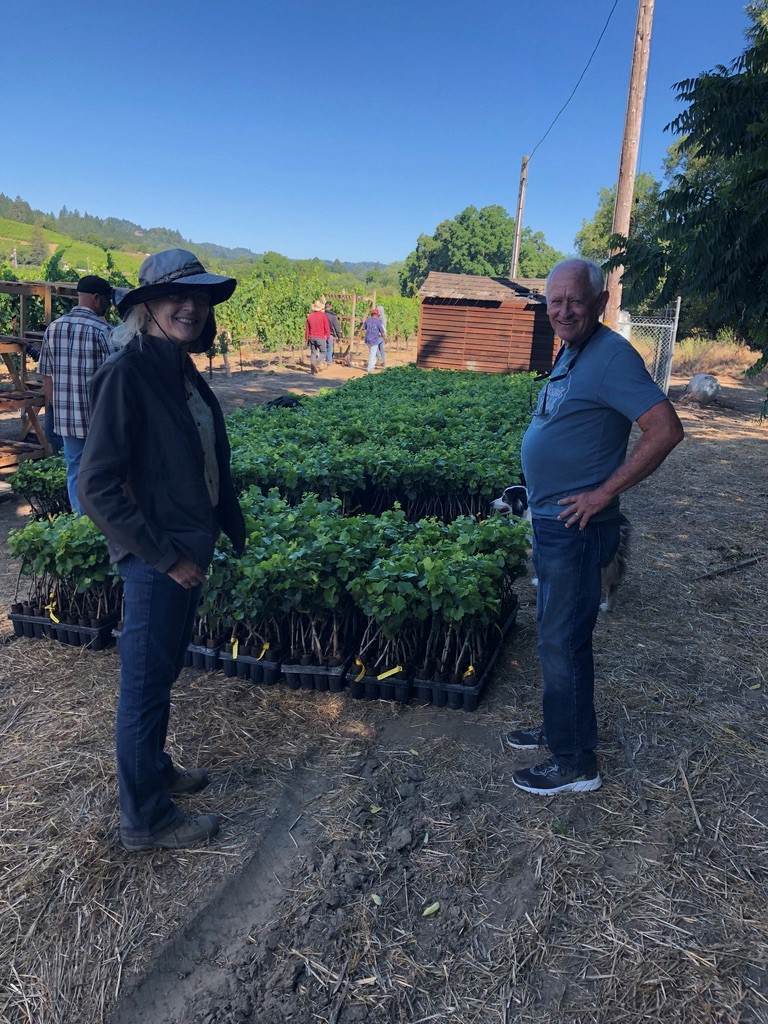
Dr. Don Hopkins from the University of Florida (right) and
Sonoma County grape farm advisor Rhonda Smith (left). We spent two days planting the young
grapevines pictured here for a Pierce's Disease biocontrol trial this summer
Now, the classic meme for
a detective show is someone with a magnifying glass. That might be enough
enlargement power for someone working on a homicide case, but the detectives in
the plant murder investigation needed something a lot more powerful. Fortunately,
there was a powerful new investigative tool that was becoming more available called
an electron microscope. The
earliest work on this tool was in the early 1930s
and it became more practical with work at the University of Toronto in 1938.
With this new tool, scientists were able to see far
smaller things than had been possible with even the best light microscopes. A
researcher at Davis in the 1960s and early 70s named S.K. Lowe assisted Goheen
and another scientist named George Nyland, using her skill with the
department’s new electron microscope. With it, they peered inside the grapevine
to see if they could catch the perpetrator of Pierce’s disease in the act. Inside
the plant’s xylem cells – essentially its water plumbing system - they saw
strange, elongated blobs which they decided to call “Rickettsia-like
organisms,” the fourth suspect in the case. They also described it as a
“fastidious bacterium” because it was apparently too picky to let people grow
it on normal culture media. Goheen, Nyland, and Lowe got a paper describing this
new finding accepted for publication in a journal called Phytopathology
on October 3, 1972, but it didn’t actually publish until March of 1973.
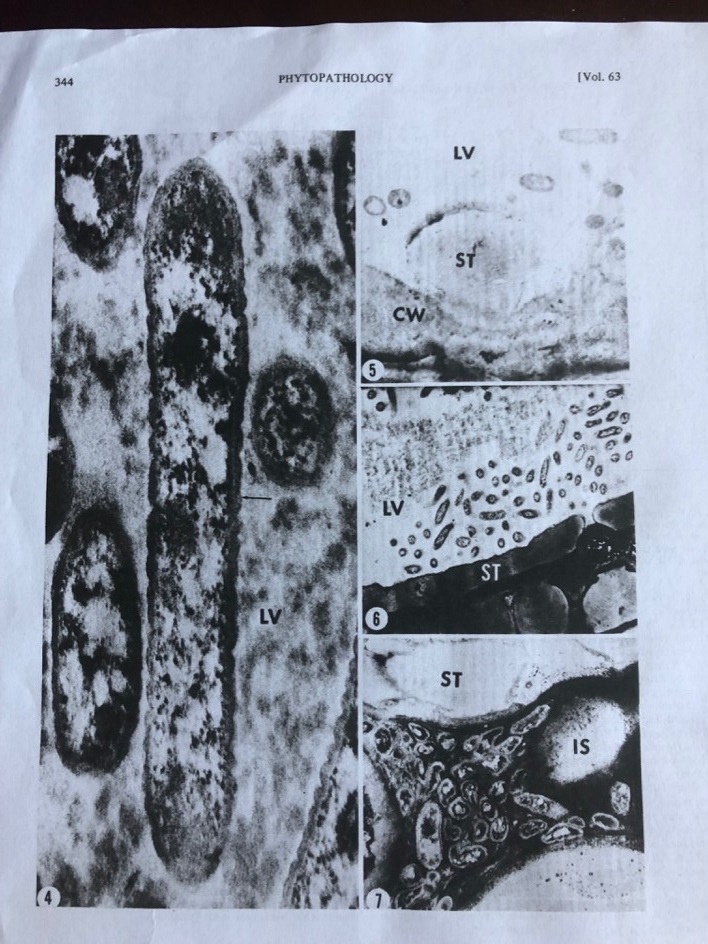
The image of
the "culprit" taken with an electron microscope and published in the
journal Phytopathology
Simultaneously, the
Florida team, Hopkins and Mollenhauer, published similar findings in the
January 1973 issue of the prestigious journal,
“Science,”
also based on what they had been able to see using an electron microscope. They
also classified the suspect as a “Rickettsia-like bacterium.” For both
investigations, those electron microscope images were “the smoking gun.” Even
though these two sets of “detectives” on opposite sides of the country fingered
the same culprit, there was actually somewhat of a rivalry. In a sense, the
Florida team “won” because their verdict came out in print two months earlier! (Remember
this was long before the internet.)
By the time I got to that
UC Davis plant pathology department in the spring of 1977, George Nyland
had
retired, and my new major
professor was the replacement for Bill Hewitt. Austin Goheen was still there
but would retire within two years. Since I was in the “Grape Lab,” I certainly
heard the UC Davis version of the tale of hunting down the culprit for Pierce’s
disease, and they were still just calling it a Rickettsia-like bacterium.
Then in 1978, another team
of scientists/detectives at a different campus of the University of California
in Berkeley finally caught
the culprit red handed by coming up with a
recipe for the medium which would finally coax this picky perpetrator to grow
in their petri plates. These new players were Mike Davis, Alex Davis, and
Sherman Thompson. They found the same organism also caused almond leaf Scorch
disease. So, the “suspect” was now “identified”
,
but we still didn’t know exactly what to call it.
It wasn’t until 1987 that
yet another team of six “detectives” used the rapidly advancing tools of
biotechnology and DNA/RNA sequencing to “fingerprint” the grape murdering
bacteria, and they declared it to be a brand
new genus,
which they gave the clever name Xylella fastidiosa: Xylella
for the Xylem of the plant in which it lives, and fastidiosa
in acknowledgement of how challenging it had been to learn to grow it outside
of its unfortunate victims. This diverse team of scientists came from labs at
the USDA, Rutgers, the Weyerhaeuser
company, the University
of Illinois, and the Centers for Disease Control, or CDC. Add that to the three
other institutions in this story and you get a sense for how hard it was to fully
understand this disease that had been killing grapes since those early days in
Anaheim, or the even earlier attempts to grow grapes in the American Southeast,
which turns out to be where the bad guys came from in the first place. In the
text version of this episode on popagriculture.com, you can also see
a map of where this bad
bacterium can now be found around the world – mostly in the Americas, but a bit
in Europe and Asia.

It turns out that Xylella
isn’t just guilty of killing grapes. It can cause problems for oaks, citrus,
and the ornamental oleander which is widely used for planting in the median
strips of California highways. Just recently, a new and unique strain of
Xylella showed up in Italy
where it “murdered” trees
in venerable old olive groves. I’ve provided a link to a “National
Geographic” article about this – it’s so sad
to think about some of those ancient trees going down. It’s a threat to olives
in Spain and Greece as well.
The tragic
death of an old olive grove, "murdered" by Xylella (Sjor,
Wikimedia commons)
 |
A picture I took this summer while flying into Sonoma County.
Note the missing (murdered) vines by the river |
But just knowing the true
cause of Pierce’s disease didn’t make the problem go away. You can’t exactly go
out and arrest bacteria that live, as it turns out, in all sorts of plants – cultivated
and wild. What the grape industry had learned was that the bug that spreads
this malady – the blue-green sharpshooter - only likes to live and feed on the
plants that tend to grow along rivers in what are called “riparian habitats.” The
sharpshooters venture out into vineyards from time to time, so the typical
pattern is you see dying vines in the
parts of vineyards closest to the Napa River in Napa county, or the Russian
River in Sonoma county.
There is an aerial photo
above that I recently took while flying into Sonoma.
You see that there are more missing (killed) vines on the side of a vineyard along
the river but not as many near the reservoirs which don’t have a
true “riparian” zone. No one would consider
taking out that natural vegetation in the riparian zone although there can be
state funds to selectively take out certain invasive plants which are actually
even worse than the native ones in terms of being a hiding place for the
bacterium and its vector.
Grape growers in these
regions mostly just deal with a certain degree of vine death because these are
regions with a great reputation for wine quality.
But there is a twist in
our murder mystery! In 1997, there was a dramatic die-off of grapevines in a
relatively new wine grape growing region called the Temecula Valley. This is in
southern California, but further inland than that original problem zone in
Anaheim. Temecula Valley had
not had any problems with Pierce’s disease because it’s pretty much a desert
and does not have those “riparian” zones that the blue-green sharpshooter accomplice
likes. But a few years earlier, probably because of some eggs on nursery stock
imported to California from the southeastern U.S., a new invasive insect had
arrived called the glassy
winged sharpshooter.
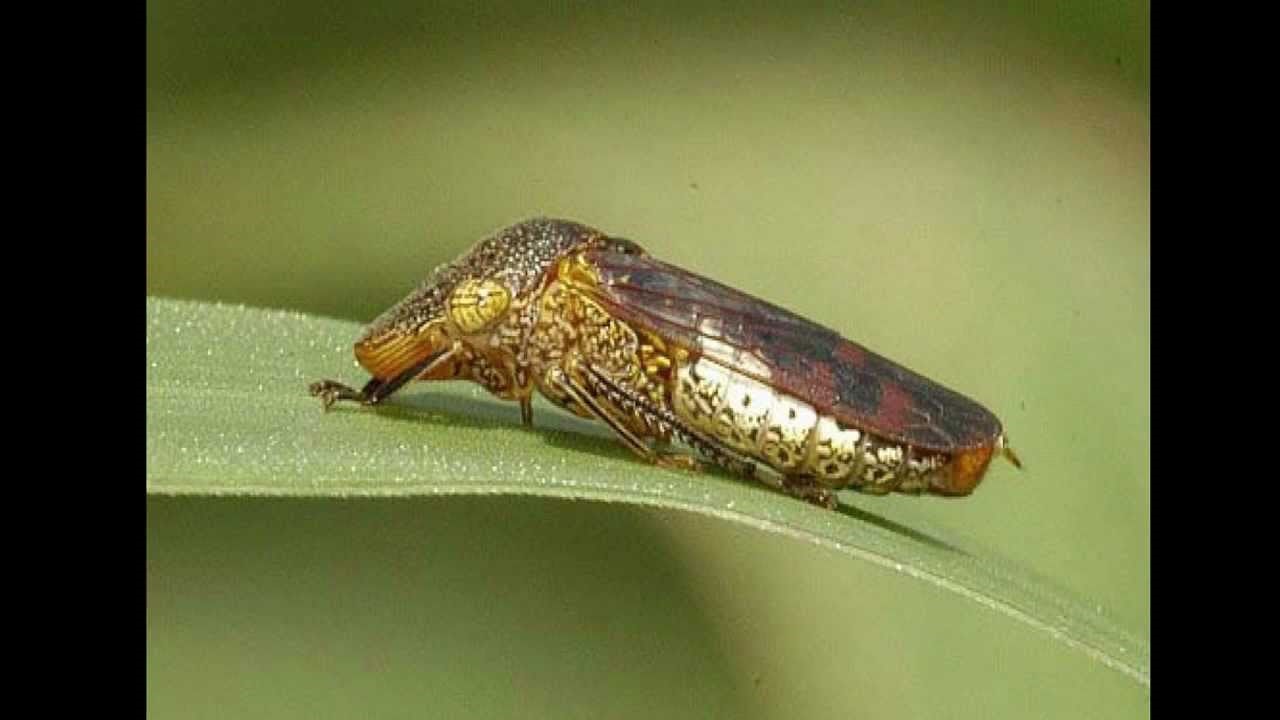
The
"accomplice" (Glassywinged Sharpshooter, image from
Now our identified
murderous Xylella
had an accomplice that isn’t at all picky about what plants it feeds on. It’s
happy on citrus and there was a lot of that in Temecula intermixed with the
vineyards. Some of the wineries lost 80 to 90% of their vines in the first few
years of this attack and it seemed like the end of grapes, not just in
Temecula, but potentially throughout the state if that new insect would spread.
The grape industry and its
supporting government agencies quickly mobilized to fight this dangerous new duo.
They found an insecticide that could be given to the roots of the citrus and
grapes through the drip irrigation system. It would then move up and protect
the plant from the sharpshooters. That put the brakes on the epidemic and the
vineyards of Temecula have been successfully replanted and protected. I visited
grape growers in that area in July and they have almost no dead vines and a
thriving tourist industry for wine tasting.
The state also put in
place very rigorous inspections and quarantines of all nursery stock moving
north to prevent the sort of hitchhiking that got the glassy wing here in the
first place. Grape growers all around the state chip in for a state run
monitoring and targeted insecticide program that has, thus far, been able to
prevent that new accomplice from moving to the
rest of the state. It’s working so far, but
no one in the industry is complacent.
The search is on for
additional tools to fight both the insect and the bacterium. It would take
another whole podcast to just list the research efforts, but briefly they
involve ideas ranging from conventional breeding, to biotech traits, to live
biocontrol agents, to insect predators and parasites, to various natural
products, to a new sprayable chemical bactericide. I’m tracking these now and
am even participating in one effort as part of my “day job” as a technology
consultant. I can’t think of anything I’d find more satisfying than to see the
grape industry find a robust set of strategies to shut down that murderous
bacterium once and for all!
Big article Hopkins and
Purcell 2002 – talks about host range, geographic …

















![Dalek image by Nelo Hotsuma from Rockwall [CC BY 2.0 (https://creativecommons.org/licenses/by/2.0)]](https://images.squarespace-cdn.com/content/v1/5b0bf627f2e6b1aad42be49d/1568895307292-RJVTB62BY64OH23FX2JR/ke17ZwdGBToddI8pDm48kL3VKmwKI3leYB51VJjLFB8UqsxRUqqbr1mOJYKfIPR7LoDQ9mXPOjoJoqy81S2I8N_N4V1vUb5AoIIIbLZhVYxCRW4BPu10St3TBAUQYVKcgK5SGg9Ovb1yloBBOHcruw_mYLfAhRzzgArFCB07Dw0L8n4JypuoE5Tg6Wg5Oyvs/Dalek.jpg?format=2500w)


